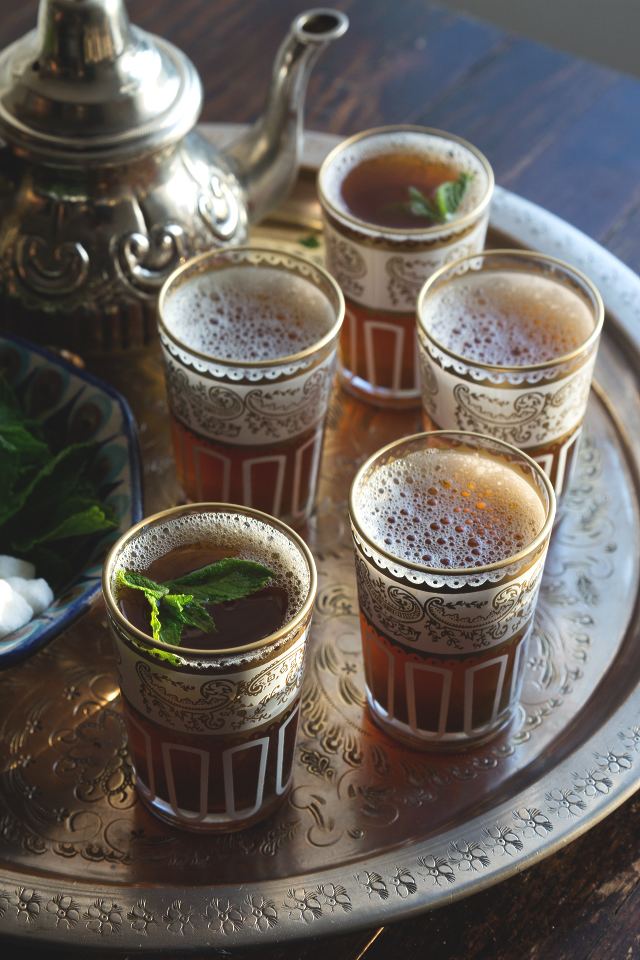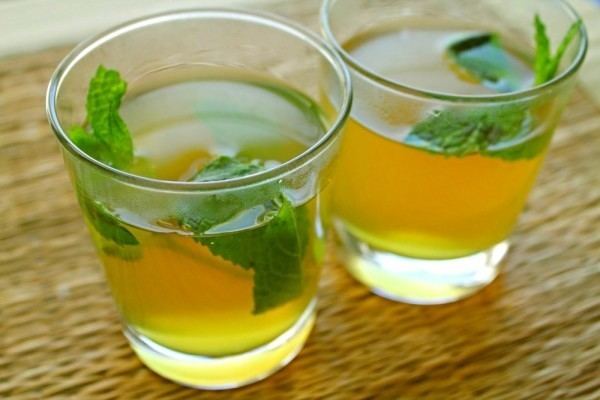 | ||
Similar Green tea, Gunpowder tea, Tajine, Pastilla, Ghoriba | ||
How to make maghrebi mint tea moroccan tea
Maghrebi mint tea (Arabic: الشاي aš-šāy; Maghrebi Arabic: التاي Atāy;Berber: ⴰⵜⴰⵢ), also known as Moroccan, Touareg and Sahrawi mint tea, is a green tea prepared with spearmint leaves and sugar, traditional to the Greater Maghreb region (the northwest African countries of Morocco, Algeria, Tunisia, Libya, and Mauritania). It has since spread throughout North Africa, parts of the Sahel, France and the Arab world. It is most closely associated with Morocco and in Spanish is known simply as "Moroccan tea", té moruno. A similar drink is prepared in Spain but is typically served chilled as iced tea in the summer, instead of hot year-round. As a combination of imported ingredients (tea from China and originally imported sugar) and a local ingredient (fresh mint), it is an early example of globalization in cuisine.
Contents
Mint tea (in Arabic, شاي بالنعناع, shāy bil n'anā', or more commonly, in dialect, التاي, it-tay) is central to social life in the Maghreb. The serving can take a ceremonial form, especially when prepared for a guest. The tea is traditionally made by the head male in the family and offered to guests as a sign of hospitality. Typically, at least three glasses of tea are served, and it is considered impolite to refuse it.

The tea is consumed throughout the day as a social activity, with tea bars filling a similar social function to alcohol drinking establishments in Europe and North America.

The cultivar spearmint (Mentha spicata) Nana, possesses a clear, pungent, mild aroma, and is the mint that is traditionally used in Maghrebi mint tea. Other hybrids and cultivars of Mentha, including Yerba buena, are occasionally used as substitutes for Nana mint.

History

Historians differ as to when they think tea was introduced to Moroccan culture. Although some say it may have been as early as the 12th century, others claim that it was only as recently as the 18th century. If the latter is correct, Moroccans were quick to embrace tea drinking as a norm of their own, resulting in Morocco's current standing as one of the top importers of tea worldwide.
The main supplier of tea to the Maghreb remains China.
Preparation

Ingredients include green tea (usually a strong Chinese tea, e.g., gunpowder or Chun Mee), fresh mint leaves in large quantity, sugar, and boiling water. The proportions of the ingredients and the brewing time can vary widely. Boiling water is used in the Maghreb, rather than the cooler water that is used in East Asia to avoid bitterness. The leaves are left in the pot while the tea is consumed, changing the flavor from one glass to the next.
It is poured into glasses from high above to swirl loose tea leaves to the bottom of the glass, whilst gently aerating the tea to improve its flavour.
In the winter, if mint is rare, sometimes leaves of tree wormwood (chiba or sheeba in Moroccan dialect) are substituted for (or used to complement) the mint, giving the tea a distinctly bitter flavor. Lemon verbena (louiza in Moroccan dialect) is also used to give it a lemon flavor. The tea is sometimes sold as a ready-to-cook mixture of tea and dried mint, which is easier to store and to prepare but has diminished flavour.
A simple and practical method runs as follows:
A more complex method is as follows:
The tea is first put in the teapot and a small quantity of boiling water is added. The tea is left to infuse for approximately 20–30 seconds. This initial liquid is poured out and kept aside. This is the "spirit" of the tea and will be added back after the tea is washed, to restore the "spirit" (the "spirit" of the tea is essentially a strong, deeply flavoured liquid from the initial infusion, which adds extra flavour to the final infusion). The tea is then "cleaned" by adding a small quantity of boiling water; that is poured out after one minute (to lessen the bitterness). This process may be repeated more than once. Mint and sugar are added (amounts vary; approximately five teaspoons of sugar for one teaspoon of tea leaves is typical), and water at the boiling point is then poured in the pot. The pot may then be taken to heat and further boiled to increase the flavour of the infusion. After three to five minutes, a glass is served and poured back in the pot two to three times to mix the tea. Tea is then tasted (sugar if needed may be added) until the infusion is fully developed.
Traditionally, the tea is served three times. The amount of time it has been steeping gives each of the glasses of tea a unique flavor, described in this famous Maghrebi proverb:
